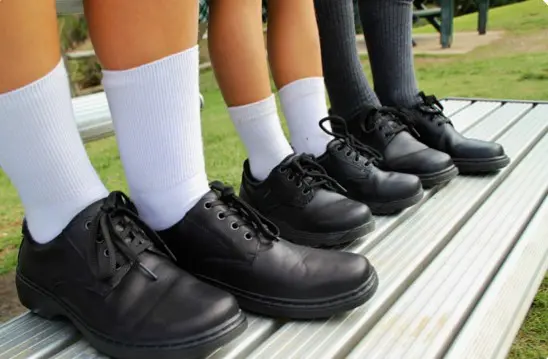The period of transition from pre-school to primary school is both exciting and full of challenges for many parents and their children. The question of “which school shoe is best?” often arises, as there are many options and differing opinions regarding what is best, as well as school uniform rules to consider.
The function of shoes will change throughout the lifespan- all babies are born with flat feet to assist with ‘packaging’ in utero. Feet then develop their arch over many years of weight-bearing and in many cases will remain flat, as Flat Feet have a genetic component. Flat Feet are not a problem unless they cause pain or unless they are very stiff. Many adults have Flat Feet and are without any complaints other than occasionally needing a wider-fitting shoe.
When very young, shoes should serve only for warmth/fashion and for protecting the toes when crawling across different surfaces. As your child begins to stand and use furniture for support you should begin to don shoes as tolerated. Choose a shoe that has a firm heel and supportive sides. When your child has only just learnt to walk, try to avoid putting them into baby-style flip-flops/thongs as these are a tripping hazard while they are still unsteady. These flip-flops or sandals are fine when your child has had a little more time to practice their walking.
School shoes are the shoes that your child will wear for the majority of their week. They will run in them at lunchtime, sit on the floor for extended periods and may walk to and from school in them. For this reason, it is important that school shoes be fitted properly. Some basic guidelines are:
- Ask for a proper shoe fitting at a shoe store. When fitting for length, the shoe fitter should allow an extra ½ size to 1 full shoe size for growth throughout the year, depending on how old your child is. You can expect rapid growth spurts between the ages of 8-13 in girls and 10-15 in boys. Outside this time children grow fairly steadily at an average rate of 6cm per year.
- Ask your child to wear their school socks when having their school shoes fitted. By wearing socks that are thinner/thicker than their everyday school socks, the shoe fitting can be inaccurate.
- Avoid choosing shoes with a high heel for girls in the first years of primary school. The muscles in the calves can become tight quickly, leading to foot pain. Additionally, a shoe with a high heel can be unstable and may lead to ankle sprains.
- Choose a shoe with leather upper where uniform rules allow. Leather will wear better over the year and will give better support to the growing foot.
- Check that the shoe is fitted correctly for width. School shoes are unique in that they offer a range of widths, including a fitting for very narrow feet. It is important that the right width is selected for comfort and reduction of foot fatigue, but also to support the development of the arch of the foot.
- Ensure you purchase new school shoes 1-2 weeks before school begins for the year to allow a ‘wearing in’ period. This will help reduce the chance of your child developing blisters.
- Watch for blisters on the heels and the tops of the toes as your child grows. This may be a sign that their school shoes no longer fit, or that they are repeatedly rubbing on one part of the foot.



